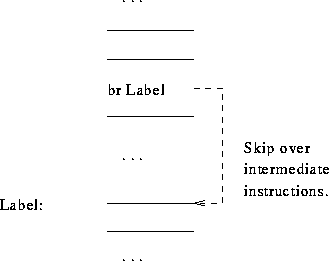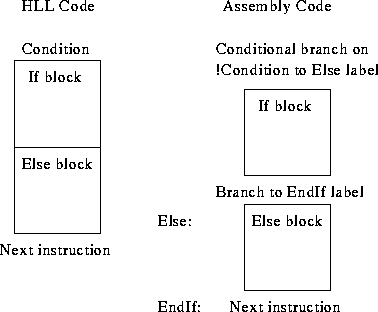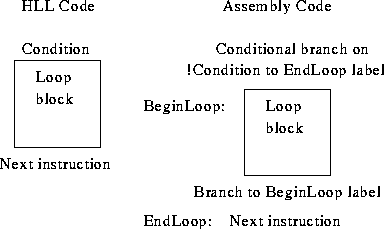
 words.
words.
Tom Kelliher, CS 220
Dec. 8, 2003
Nothing new.
Operands and instruction formats.
Procedure invocation I.
addi $t0, $s0, 8 # An immediate operand.Why no
subi?
lui $s0, 0x5555
ori $s0, $s0, 0xaaaa
$at.

 words.
words.
The complete set, all synthesized from beq, bne, and slt.
Branch instructions use a signed 16-bit offset field; hence they can jump
 instructions (not bytes) forward or
instructions (not bytes) forward or  instructions backwards. The jump instruction contains a 26 bit
address field (the third instruction format).
instructions backwards. The jump instruction contains a 26 bit
address field (the third instruction format).
b label instruction
Unconditionally branch to the instruction at the label.
beq Rsrc1, Src2, label on Equal
Conditionally branch to the instruction at the label if the contents
of register Rsrc1 equals Src2.
beqz Rsrc, label on Equal Zero
Conditionally branch to the instruction at the label if the contents
of Rsrc equals 0.
bge Rsrc1, Src2, label on Greater Than Equal
bgeu Rsrc1, Src2, label on GTE Unsigned
Conditionally branch to the instruction at the label if the contents
of register Rsrc1 are greater than or equal to Src2.
bgez Rsrc, label on Greater Than Equal Zero
Conditionally branch to the instruction at the label if the contents
of Rsrc are greater than or equal to 0.
bgt Rsrc1, Src2, label on Greater Than
bgtu Rsrc1, Src2, label on Greater Than Unsigned
Conditionally branch to the instruction at the label if the contents
of register Rsrc1 are greater than Src2.
bgtz Rsrc, label on Greater Than Zero
Conditionally branch to the instruction at the label if the contents
of Rsrc are greater than 0.
ble Rsrc1, Src2, label on Less Than Equal
bleu Rsrc1, Src2, label on LTE Unsigned
Conditionally branch to the instruction at the label if the contents
of register Rsrc1 are less than or equal to Src2.
blez Rsrc, label on Less Than Equal Zero
Conditionally branch to the instruction at the label if the contents
of Rsrc are less than or equal to 0.
blt Rsrc1, Src2, label on Less Than
bltu Rsrc1, Src2, label on Less Than Unsigned
Conditionally branch to the instruction at the label if the contents
of register Rsrc1 are less than Src2.
bltz Rsrc, label on Less Than Zero
Conditionally branch to the instruction at the label if the contents
of Rsrc are less than 0.
bne Rsrc1, Src2, label on Not Equal
Conditionally branch to the instruction at the label if the contents
of register Rsrc1 are not equal to Src2.
bnez Rsrc, label on Not Equal Zero
Conditionally branch to the instruction at the label if the contents
of Rsrc are not equal to 0.
j label
Unconditionally jump to the instruction at the label.
jal label and Link
jalr Rsrc and Link Register
Unconditionally jump to the instruction at the label or whose address
is in register Rsrc. Save the address of the next
instruction in register 31.
jr Rsrc Register
Unconditionally jump to the instruction whose address is in register
Rsrc.
Write MIPS code fragments corresponding to the following:

if (i < 12) ++i; else --j;

i = 1;
j = 0;
while (i < 200)
{
j += i;
i *= i;
}
Working in groups of 2--3, solve as many of the following as possible. Turn in your solutions.
j = 0; for (i = 0; i < 10; ++i) j += i;
j = 0;
for (i = 0; i < 10; ++i)
if (i > 5)
j += i;
while (i > 0 && i < 10) ++i;
if (i < 12 && j > 3 || k != 0) ++i; else if (i == 33) --j; else k += 2;
while (save[i] == k) i += k;requires execution of both a conditional branch and an unconditional jump each time through the loop. Produce the naive code.
Optimize the naive code so that only a conditional branch is executed each time through the loop.
$a0.
$a1.
$v0.